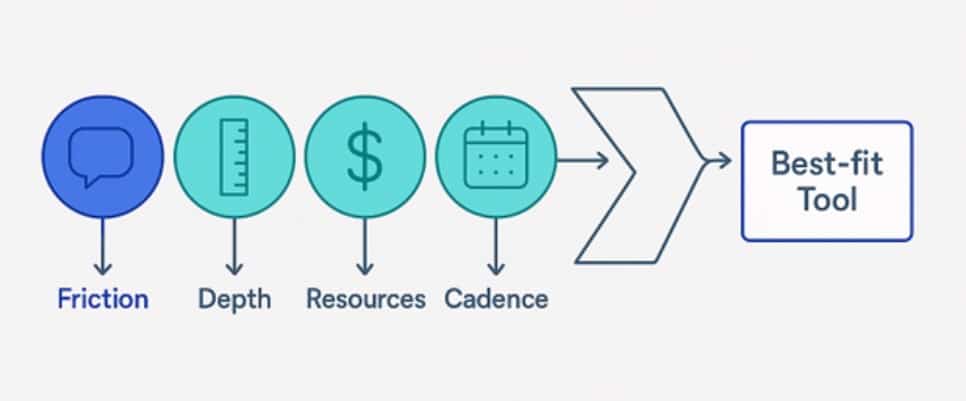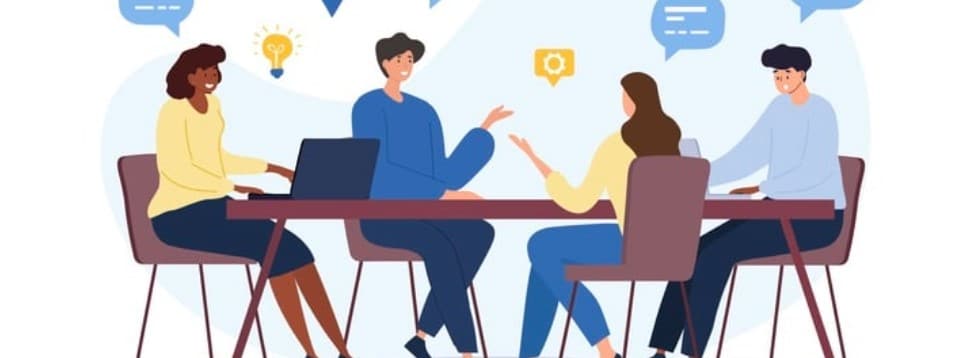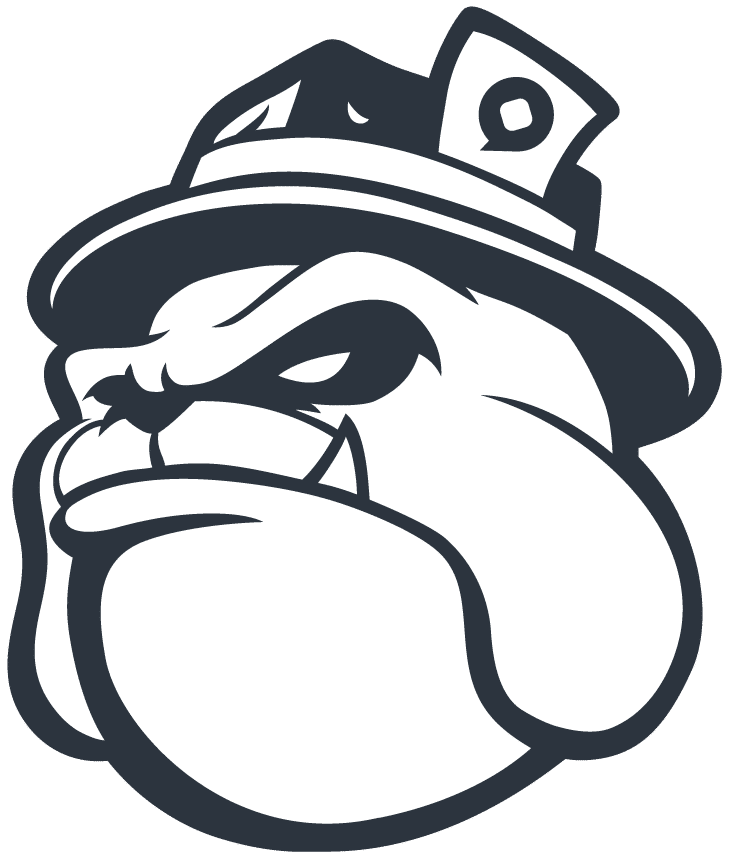Great campaigns start with great chemistry—yet most PR and marketing teams still guess how colleagues prefer to think, decide, and deliver. Gallup reports that more than 90 percent of Fortune 500 companies now use CliftonStrengths—evidence that data-driven personality insights beat gut feel.
When you can see the numbers, you assign roles faster, smooth feedback loops, and ship work that sticks the first time. In the pages ahead, you’ll compare seven proven team-personality assessment tools so you can choose the one that fits your crew.

Why knowing personality data lifts team performance
When teammates understand the reasons behind each other’s work habits, friction drops and projects speed up.
In a 2023 study that tracked 3,698 people on 593 teams across 5,000 tasks, researchers found that sharing Big-Five personality data produced “significantly higher task scores,” especially when deadlines were uncertain. Earlier work from the University of Central Florida linked traits such as dependability and flexibility to essential teamwork behaviors like coordination and backup support.
Numbers aside, the payoff shows up every day. Once a copywriter sees that a colleague gains energy from rapid brainstorming but fades in extended threads, the team can tweak meeting formats and feedback loops to bring out that person’s best work. Naming preferences—introvert or extravert, challenger or harmonizer—gives the group a neutral vocabulary that turns potential clashes into deliberate choices.
For PR and marketing teams, where timelines are tight and creativity must align with client guardrails, this clarity translates into faster approvals, sharper copy, and campaigns that hit the brief the first time. Personality data isn’t a perk; it’s a proven performance lever for any crew that depends on collaboration.
How to choose the right assessment

Before you click “buy,” pause and name the business problem you’re solving.
Is your team tripping over misread Slack messages, or are you redesigning talent strategy for the next fiscal year? That answer shapes every other decision, from how deep the data should go to how much you can spend.
Budget matters, but only if the money drives change. U.S. HR teams already invest about $2,524 per employee each year on HR programs, with $188 tagged for learning and development, so unused reports are costly twice over, according to the Society for Human Resource Management.
Match tool complexity to culture: just as you’d evaluate the latest HR tools every PR & marketing team should know for your workflow, select a personality-assessment platform that fits your team’s dynamics and budget.
Ask these four questions to zero in on the best team personality assessment tool:
- What specific friction are we fixing?
- How detailed do the findings need to be?
- How much money and time can we invest now and in follow-up?
- Will we act on the results weekly, monthly, or rarely?
Choose the option that clears every hurdle; anything less is just personality trivia.
Team Personality Assessment Tools – Comparative Guide
This guide compares seven of the most widely used team assessment tools, organized under a consistent structure: Overview, How It Works, Pricing, Best For, and Evidence & Insights.
Each tool helps teams understand how people think, communicate, and collaborate — but their focus and application differ significantly
Comparative Matrix
| Tool | Core Focus | Typical Price (per person) | Best For |
| TeamDynamics | Team-based behavioral analytics (16 team types) | $29 Solo / $39 Pro (one-time) | Continuous collaboration improvement in hybrid teams |
| Myers-Briggs | 16-type style awareness | $99.95 | Fast empathy boost at an off-site |
| CliftonStrengths (StrengthsFinder) | Strength discovery and alignment | $24.99 (Top 5) / $59.99 (Full 34) | Assigning roles by natural talent |
| EverythingDiSC | Four-style shorthand for communication | $72–$90 per profile | Smoothing day-to-day friction |
| Enneagram | Motivations and stress patterns | $20 single / $10–$18 bulk | Deep cultural and EQ work |
| Big Five | Research-grade trait spectrum | $37 validated report | Data-driven hiring or gap analysis |
| Predictive Index (PI) | Talent-optimization platform | Starts at $4,950 per year | Enterprise-wide hiring and team design |
Detailed Overviews:
1. TeamDynamics
Overview:
TeamDynamics identifies your team’s unique “TeamDynamics type” — a team personality describing how your group communicates, processes information, makes decisions, and gets work done. It uses a research-backed 16-type framework centered on collective behavior, not individual traits, making it more relevant for modern workplaces than MBTI or Enneagram.
Each participant receives a CoDynamics profile showing how their working style aligns or diverges from the team’s overall pattern. The tool highlights strengths, gaps, and friction points to improve collaboration and leadership alignment.
How It Works:
Each team member completes a short, research-backed assessment (a few minutes). The platform analyzes all responses to produce:
- A team-level profile (one of 16 TeamDynamics types) showing communication, decision, and execution patterns.
- Individual CoDynamics results highlighting personal alignment with the team.
- Tactical guidance for managers on how to lead and structure their team effectively.
No integrations or IT setup are needed — it’s a standalone, self-serve platform.
Pricing
- Free trial: Sample report.
- Solo plan: $29 (one-time).
- Pro plan (2–20 users): $39 per user (one-time).
- Enterprise / Consultant plans: Custom pricing.
Best For
Modern professional teams (tech, consulting, product, operations) seek a real-world view of team behavior to improve collaboration continuously.
Evidence & Insights
Designed specifically for workplace collaboration, not personality theory. Makes “invisible dynamics visible,” empowering teams to adapt communication and workflow effectively.
2. Myers-Briggs Type Indicator (MBTI)
Overview:
MBTI categorizes people into 16 personality types based on preferences in perception and judgment, helping teammates understand how they and others process information and make decisions. A recent team-building assessment tools buyer’s guide highlights MBTI for its familiar language and minimal ramp-up time, making it a go-to choice when you need quick empathy wins at an off-site.
How It Works:
Participants complete an online inventory that produces a four-letter type (e.g., INFP, ESTJ). Team reports reveal personality diversity and potential friction points.
Pricing:
$99.95 per participant (minimum three people).
Best For:
Quick empathy-building exercises or off-site retreats.
Evidence & Insights
Used by 88% of Fortune 500 companies. It fosters awareness but lacks the statistical precision of trait-based models like the Big Five; results should be treated as conversation starters rather than static labels.
3. CliftonStrengths (StrengthsFinder)
Overview:
CliftonStrengths helps individuals identify and apply their top talents by ranking 34 themes related to thinking, relating, and executing.
How It Works:
An online assessment ranks participants’ strengths and produces personalized reports, which can be used for role alignment and performance coaching.
Pricing
- Top 5 strengths: $24.99
- Full 34 themes: $59.99 (one-time; lifetime access).
Best For
Building strengths-based teams that assign work according to natural talent.
Evidence & Insights
Gallup studies link strengths development to higher sales, profit, and engagement across 20,000+ teams. Works best with ongoing coaching rather than a single session.
4. EverythingDiSC
Overview
DiSC simplifies workplace behavior into four key dimensions — Dominance, Influence, Steadiness, and Conscientiousness — giving teams a shared shorthand for collaboration.
How It Works
A 15-minute adaptive survey generates individual and group profiles. A facilitator-led debrief helps participants apply insights to daily work.
Pricing
$72–$90 per person; discounts available for large groups.
Best For
Teams that want better communication and reduced friction in high-speed or high-stakes environments.
Evidence & Insights
Adopted by over 150,000 organizations and 10 million learners globally; holds a 97% satisfaction rate.
5. Enneagram
Overview
The Enneagram describes nine motivation-based personality types, each tied to core desires, fears, and coping styles. It explores what drives people — not just how they behave.
How It Works
Participants complete the 144-question RHETI assessment, which generates a personalized profile with stress and growth pathways.
Pricing
$20 per person (single) or $10–$18 in bulk.
Best For
Teams pursuing emotional intelligence and cultural development, where deeper interpersonal understanding matters.
Evidence & Insights
In a 2024 TeamDynamics study, 71% of marketing professionals reported improved psychological safety after using the Enneagram for team discussions.
6. Big Five
Overview
The Big Five model measures personality across five broad, empirically supported dimensions: Openness, Conscientiousness, Extraversion, Agreeableness, and Neuroticism.
How It Works
A 240-item questionnaire yields continuous scores along each dimension, allowing for nuanced interpretation across teams.
Pricing
$37 per validated NEO-PI-3 Basic Report (bulk discounts available).
Best For
Organizations needing data-driven insights for hiring, leadership development, or team gap analysis.
Evidence & Insights
A 2021 review of 54 meta-analyses (554,000+ subjects) found Conscientiousness correlates ρ = 0.19 with performance; others show moderate predictive validity.
7. Predictive Index (PI)
Overview
The Predictive Index is a talent-optimization platform combining behavioral and cognitive analytics to align people, roles, and business strategy.
How It Works
A six-minute behavioral checklist maps four core drives (Dominance, Extraversion, Patience, Formality). Reports visualize team composition and reveal gaps relative to strategic goals.
Pricing
Starts at $4,950 per year, covering unlimited assessments and users.
Best For
Enterprise-scale organizations optimizing hiring, succession planning, and workforce design.
Evidence & Insights
Used by 25 million+ individuals; 94% of 400 validation studies show significant job-performance prediction. Works best when embedded across the talent lifecycle.
Match the tool to your team’s pain point
Translate vague goals into concrete symptoms, then pick the team personality assessment tool that research says works best:
- Timelines slip because updates vanish in chat → a live pulse like TeamDynamics; one field study logged a 22 percent drop in unresolved Slack threads after eight weeks.
- Brainstorms drag because people talk past each other → a communication lens such as DiSC or MBTI to surface style clashes in minutes.
- Work feels lopsided, with some buried and others coasting → CliftonStrengths; Gallup links strengths-based teams to 12.5 percent higher productivity.
- Morale dips and feedback stings → the deeper “why” uncovered by the Enneagram can restore psychological safety.
- You’re scaling headcount or hiring for new markets → the data depth of the Big Five, or go all in with Predictive Index, whose talent-optimized companies post 34 percent higher employee performance and 30 percent better top-talent retention.
Layer budget, time, and culture realities on top, and schedule a quick retro every quarter to confirm the tool still solves the symptom you started with.
Turn insights into daily habits
- Hold a retro two weeks after the debrief. In a meta-analysis of 31 studies, structured debriefs lifted team effectiveness by 20–25 percent compared with control groups. Ask what changed, what stuck, and what still feels fuzzy.
- Pin takeaways where work happens. Slack channel headers, project briefs, and even email signatures help. Seeing “High-C, loves detail” in context prevents endless follow-up threads.
- Refresh every quarter. Spacing research shows that review intervals of roughly 10–20 percent of the desired retention window maximize recall. A three-month check-in keeps the language of your team personality assessment tool alive without meeting fatigue.
- Pair new hires with a framework buddy. A quick walkthrough of the team map helps rookies speak the same shorthand from day one.
When these small habits take root, you spend less time decoding teammates and more time delighting clients, and that’s how personality data graduates from slide deck to performance engine.
Conclusion
At its best, a team personality assessment isn’t a quiz — it’s a mirror and a map.
It shows who your people are when the deadline hits, when feedback lands, and when the client changes scope at 5 p.m.
The right framework doesn’t replace intuition; it sharpens it. When you can see how your team naturally collaborates, decides, and delivers, you stop managing personalities and start engineering chemistry. That shift turns work from a guessing game into a growth system.
Start small: pick one tool that fits your pain point, pilot it with one campaign team, and track metrics that matter — turnaround time, approval speed, revision counts. Within a few cycles, you’ll see whether insights are sticking or sliding.
Because in the end, personality data is only as powerful as the behavior it changes. Teams that build a shared language for their differences don’t just get along better — they ship stronger work, faster, and with less friction. And that’s how chemistry becomes a competitive advantage.
Frequently Asked Questions (FAQ)
1. How do I know which team assessment tool is right for us?
Start by naming the friction you want to fix.
If you need real-time visibility into collaboration patterns, choose TeamDynamics. For quick empathy wins, MBTI or DiSC work well. If you’re redesigning roles or talent strategy, go deeper with CliftonStrengths, Big Five, or Predictive Index. Match tool complexity to your problem’s depth — not to the marketing hype.
2. How much time should a team expect to invest?
Most assessments take 10–30 minutes per person.
The greater investment is in the follow-up conversation — that’s where value compounds. Plan a 60–90 minute debrief for most tools, and a team retro two weeks later to track what’s changed. Research shows debriefs lift team effectiveness by up to 25 percent.
3. Do these tools require a facilitator or coach?
Not necessarily.
Tools like TeamDynamics and CliftonStrengths are self-serve and intuitive for internal rollout. Frameworks such as DiSC, MBTI, and Enneagram often benefit from certified facilitators, especially for larger or more sensitive teams. If you’re introducing personality data for the first time, an external coach can help keep discussion objective and constructive.
4. How do we turn personality insights into daily habits?
- Start with micro-habits:
- Add personality shorthand to Slack bios or project briefs (“High D — direct and decisive”).
- Begin meetings with a quick “how I work best” check-in.
- Review results quarterly to keep the language fresh.
- Embedding the data in where work happens — not just in slide decks — ensures it drives daily collaboration.
5. Are personality assessments scientifically valid?
Most mainstream tools have decades of data behind them, but validity varies.
The Big Five (NEO-PI-3) is considered the gold standard in psychometric reliability.
CliftonStrengths and Predictive Index have strong empirical support in workplace performance.
MBTI, DiSC, and Enneagram are better seen as practical communication frameworks rather than strict psychological measures.
6. How often should we retake or revisit the assessment?
Most teams refresh their data annually or after major organizational shifts (e.g., leadership changes, mergers, or remote transitions).
For dynamic teams using TeamDynamics, ongoing analytics or quarterly check-ins can capture evolving collaboration patterns more accurately.
7. What’s the biggest mistake teams make after taking these assessments?
Treating results as labels instead of launchpads.
When people say “I’m an introvert, so I don’t brainstorm,” the insight becomes a cage. The goal isn’t to box people in — it’s to build bridges between styles.
The best teams use personality data as a shared language for flexibility, not as a script.
8. How can small teams justify the cost?
Think of it as a collaboration investment, not a line item.
Even a $500 spend on the right assessment can save dozens of hours of misalignment each quarter.
For lean teams, TeamDynamics’ one-time pricing or CliftonStrengths Top 5 report provides the best cost-to-impact ratio.
9. Can we combine insights from multiple tools?
Yes — and many high-performing teams do.
For example, use CliftonStrengths for talent alignment, TeamDynamics for ongoing behavioral analytics, and DiSC for communication shorthand.
The key is to translate between frameworks using consistent, shared language so insights complement rather than compete.
10. What’s the ideal rollout sequence?
- Kickoff — Explain the “why” before the “what.”
- Assess — Have everyone complete the survey individually.
- Debrief — Discuss results as a team, not as a scorecard.
- Apply — Integrate takeaways into workflows and feedback loops.
- Revisit — Schedule a short quarterly check-in.
Consistency beats complexity. Even light-touch follow-ups sustain more value than a single, well-intentioned workshop.




